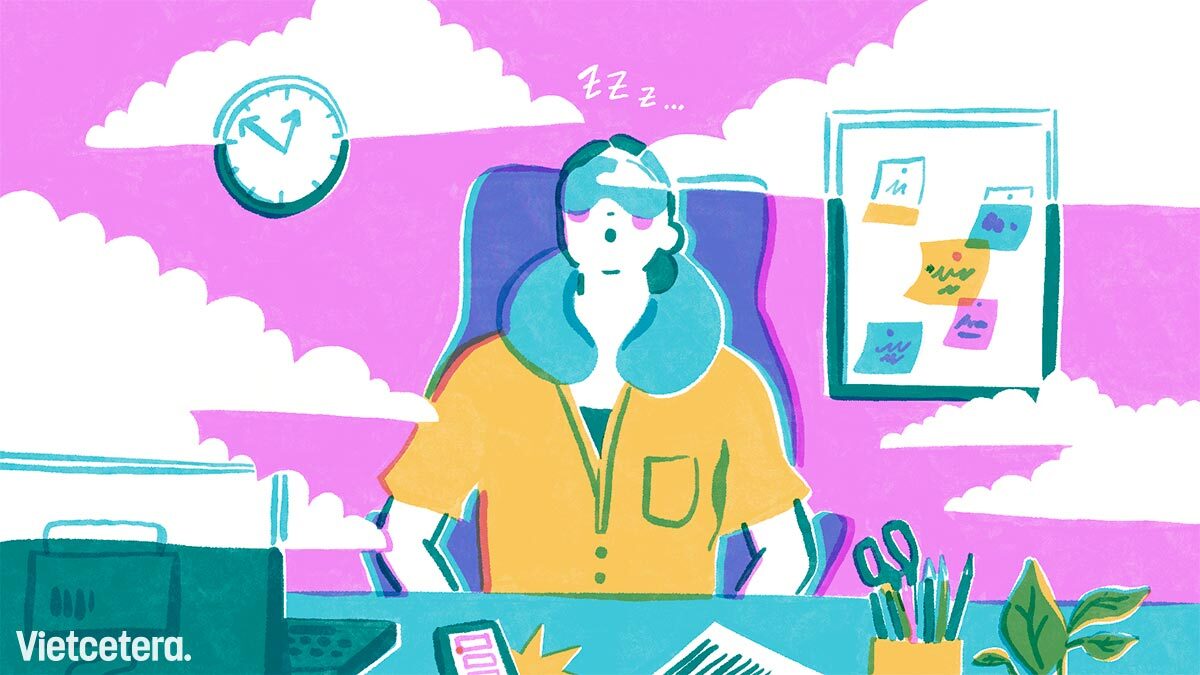The sight of motorbike drivers napping on top of their vehicles at noon under the shade of xà cừ isn’t as shocking as the fact that they can actually sleep so soundly in such a position. In Vietnam, napping isn’t just socially acceptable; it’s part of the local culture.
The midday nap, known as giấc ngủ trưa in Vietnamese, is a widely practiced tradition in workplaces throughout the country, particularly in industries that require manual labor. Construction workers often head to nearby public parks to eat lunch and take a short nap between noon to 2 pm before they go about their afternoon duties.

Read: ‘Hustle Culture’: Why Do Millennials Have Sleep Issues?
The practice is also prevalent in offices, where employees turn off the lights after lunch, pull out a mat, a pillow, and a blanket and lie on the floor for a 30-minute snooze.
While there have been a few debates about whether post-lunch nap time fosters productivity or only makes workers feel groggy, many embrace the practice. After all, what workers do during their lunch break — clearly stipulated in the Labor Code of Vietnam— is all up to them.
Origin of the nap tradition
The midday nap culture in Vietnam has a long history that dates back centuries ago when the country was still very much of an agricultural society, the same way the cultures of “siesta” in Spain, “pennichella” in Italy, and “wujiao” in China came about.
Farmers, who were the backbone of the economy, worked in the fields from dawn until midday and then took a break during the hottest hours of the day to avoid fatigue and dehydration. They would lie in the shade of trees or inside a small wooden shelter to doze off.
After the midday break, farmers would typically return to physically demanding work in the fields until late afternoon or early evening. Farmers often had to work longer hours during planting and harvesting seasons to get the job done, making midday naps more essential.

The tradition of napping became deeply ingrained into Vietnamese culture beyond farming and has now become an essential part of Vietnamese life.
Even as Vietnam shifted from an agriculture-based economy to an urbanized industrial society, napping in the middle of the day isn’t just embraced; it’s also highly encouraged, with some companies providing designated nap rooms for a good power nap.
Is there economic value to midday napping?
Some experts argue that while taking a midday nap is a cultural phenomenon that can’t be easily eliminated, it’s impacting Vietnam’s big ambition for global integration.
In 2014, a tech company banned its employees from taking naps inside the office, reasoning that overseas customers were shocked to see Vietnam-based staff sleeping at work.

Vietnam is striving to become a manufacturing and startup hub, banking on low labor costs and a young workforce that’s highly adaptable and flexible to digital shifts. The company said that for local firms to “win contracts from foreign partners, Vietnamese should give up the habit of napping at noon.” It further stated that sleeping in the offices is “not good for the company’s image.”
That may be true. In bustling cities like Saigon, some industries may not be able to give employees a long lunch break for napping. It’s not uncommon for businesses to skip putting up a “closed for lunch break” sign because they don't want to turn away customers. But let’s be honest — seeing a store closed at 12:30 pm is sometimes frustrating, especially when you only have your lunch break to run personal errands.
But then again, while company cultures vary, they should be built with employees’ welfare in mind. Various studies have shown that napping can improve cognitive performance and productivity and reduce fatigue among employees. Slipping naps into the work routine boosts the mind, making employees emerge from slumber mentally sharper, like they’ve had a good night’s sleep.

There will be constant cultural shifts at work, especially as more foreign firms enter the local market and Vietnam is increasingly catering to international customers. There will also be new definitions of what constitutes a nap, or what’s acceptable to specific industries.
But Vietnam’s napping culture will stay, as companies navigate the demands of a modern-day economy. If the windless, unforgiving heat from 11 am to 2 pm is to be considered, allowing employees a proper midday downtime — whether they sleep beneath their desk, rest their head on the desk, or recline on a chair with a neck pillow — is only humane.
